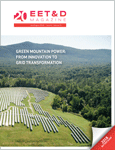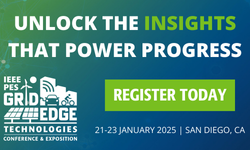In today’s complex and rapidly changing technological electric power landscape, the need for economic and environmental improvements has never been more critical. Enter the Electric Power Research Institute’s (EPRI’s) Efficient Electrification Initiative – a research, development, and demonstration effort that explores the benefits and costs of increasing the share of end-use served by electricity. The embodiment of this initiative is EPRI’s upcoming Electrification 2018 International Conference & Exposition at the Long Beach Convention Center in August. This first-of-its-kind conference provides an opportunity for participants to hear from and interact with leaders in electrification, industry, academia, government, and the vendor community, from the United States and around the world.
The conference consists of workshops, exhibitions, tours, panels, networking events, and five diverse conference tracks covering an expansive breadth of topics associated with efficient electrification.
Industrial Electrification
Industry and manufacturing remain the lifeblood of a nation’s economy, even as other sectors (for instance, the service economy) grow in prominence. Industry is vital to trade balances, high-wage jobs, and national security. As manufacturing evolves to compete in the world economy, electric technologies play an important part in sustaining competitive capabilities.
In addition to higher energy efficiency (per-unit-of-good produced), electrification in the industrial sector can offer a range of non-energy benefits including:
- Increased productivity through greater processing speed;
- Improved process control, including responsiveness, reliability, and process intelligence; and
- Reduced emissions at the point of use, and otentially overall, as electricity produced with low-or no-carbon emissions becomes a largerportion of the generation mix.
Residential and Commercial Electric Technologies
Complementing the diverse industrial track is the residential and commercial technologies track. “This is fertile ground for efficient electrification,” explains EPRI Senior Program Manager and track chair Ron Domitrovic. “It’s where heat pumps, energy-efficient buildings, customer-connected electric devices, and smart communities rule.” In just one example of these technologies, widespread adoption of next-generation heat pumps could save utility customers money, enhance demand response, and reduce the environmental impact of space conditioning.
A full-day, pre-conference workshop will focus on the opportunities and challenges with electrification of residential and commercial buildings. Six breakout sessions over three days will cover advanced heat pump technology, the future of water heating, the potential of customer-connected devices, understanding customers, and community and campus electrification.
Another session will cover advanced energy communities and zero net energy neighborhoods. What are utility opportunities and customer options in these integrated, connected, and electrified developments?
Electric Transportation
Consider the following trends: a significant rise in auto¬maker electric vehicle (EV) spending, the ever-increasing range of EV models now available, and declarations from cities and nations around the world to phase out petroleum-fueled vehicles. At the same time, charging infrastructure is growing, and autonomous vehicles are proliferating. Do these recent trends indicate the approach of a tipping point for widespread, global adoption of electric transportation? If so, how can industry stakeholders prepare for and enable this growth?
The electric transportation track is designed to benefit experienced industry experts as well as those less familiar with electrification. Spirited dialogue and exchange are expected in expert panel discussions.
Innovative and Breakthrough Technologies
This conference track is unique because it showcases exciting, emerging technologies. “We’re looking at breakthrough solutions for utilities, their customers, and society,” explains EPRI Technical Leader and track chair Beth Hartman.
A key part of this track is the growing EPRI Incubatenergy Network. Originally launched with a U.S. Department of Energy grant, this national consortium of 20 energy-focused technology incubators and accelerators collectively supports more than 500 companies that have raised more than $1.6 billion in funding. The network supports solutions such as advanced EV charging systems, data analytics and artificial intelligence applications, advanced indoor agriculture, smart buildings, smart cities, and more.
Grid Modernization
The potential benefits of electrification can only be realized if the underlying power delivery system can support them. For example, electrification has the potential to add new, significant load shapes to transmission and distribution (T&D) systems. This adds another challenge to T&D systems that already must evolve to incorporate higher levels of renewable generation and distributed resources. How will T&D system planners adapt as electricity’s share of end-use energy consumption continues to increase?
This track highlights the T&D infrastructure components – beyond the poles and wires – that utilities need to address as electrification progresses.
Policy and Regulatory Landscape
Policy and regulatory developments can impact the acceleration and adoption of electricity at the point of end-use. This track will explore the policy and regulatory implications and potential developments in five sessions:
- The Big Picture: Key Policy Considerations for Efficient Electrification
Features a dynamic panel that will focus on high-level policy and regulatory considerations when evaluating efficient electrification’s potential contribution to a cleaner, more flexible, reliable, and affordable energy future.
- Charging Ahead: Preparing for Transportation Electrification
Explores the policy issues surrounding transportation electrification; transportation electrification’s role in achieving public policy goals; and how to optimize investments in a way that benefits all customers and the grid.
- Policies to Achieve Flexibility in an Increasingly Electrified System
Examines policies, markets, and incentives that could help promote seamless integration of efficient electric end uses and cleaner electricity resources.
- Evaluating Electric End Uses in the Context of an Evolving Energy System
Focuses on specific considerations for evaluating customer end uses and their energy sources.
- Electrification: The Key to Unlocking Smart Communities?
Explores the connection between electrification and smart communities.
These sessions will feature energy government leaders from Illinois, Minnesota, Ohio, and California; represen¬tatives from a regional transmission organization and a transportation alliance; and electric utility executives.
Costs and Benefits of Electrification
“Understanding the potential for electrification first requires a comprehensive view of the power sector and the rest of the economy, including all of the associated options and their cost and performance,” explains EPRI Director of Strategic Analysis, Safety, and Sustainability Bill Gould. “Different nations, regions, and localities have very different characteristics – whether its climate, policy or cost of different energy and technology options – and those specific characteristics need to be taken into consideration. What may be an effective strategy in one place may not work in another.”
This session track will explore the many needed considerations for examining the potential benefits and costs of electrification.
 Rob Chapman is vice president, Energy and Environment, at EPRI. He leads the team responsible for research and analysis on environmental science and technology issues from the generation, transportation,and use of energy, and is the executive business lead for EPRI’s Efficient Electrification Initiative. His group’s research addresses environmen¬tal, health, and economic issues focusing on air, land, water, and energy challenges; informing public policy; enabling sustainable practices, and improving occupational health and safety.
Rob Chapman is vice president, Energy and Environment, at EPRI. He leads the team responsible for research and analysis on environmental science and technology issues from the generation, transportation,and use of energy, and is the executive business lead for EPRI’s Efficient Electrification Initiative. His group’s research addresses environmen¬tal, health, and economic issues focusing on air, land, water, and energy challenges; informing public policy; enabling sustainable practices, and improving occupational health and safety.








